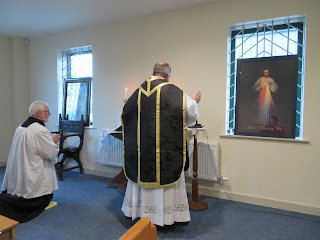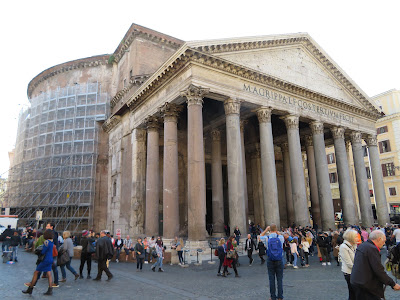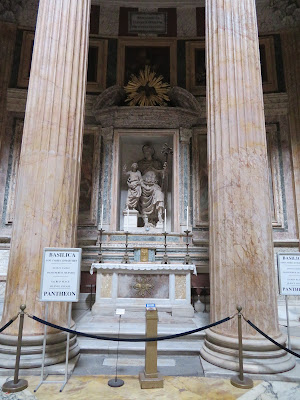From Fr. Anthony Cogan's The Diocese of Meath Ancient & Modern (Published: Dublin, 1862 by John F. Fowler):
"According to Harris St Finian was seated at Clonard in 520. Usher places this event at 544 The most probable year seems to have been 530. Usher quotes from a registry of the diocese of Meath that St Finian got the domain of Clonard from St Kieran of Clonmacnoise. By other authorities Clonard is said to have been a desert when St Finian founded his monastery and by the untiring labours of the monks it was converted into a rich and luxuriant soil. However that may be it is certain that the monastery of Clonard became one of the greatest schools in Europe. Venerable Bede bears testimony to its learning and to the hospitality with which foreign students who crowded thither were entertained. It was frequented by youths not only from Ireland and the British Isles but even from Armorica and Germany so that the number at one time was computed at three thousand. Thus in the Office of St Finian we read:-
Trium virorum millium Sorte sit doctor humilis Verbi his fudit fluvium Ut fons emanans rivulis
En hie rexit in Uteris Vise vicimus regire Hie se jungebat superis Hie transfertur egregii
Some of the greatest names in the Annals of Ireland are recorded as having studied scripture and theology under St Finian of Clonard. St Columbkill, the apostle of the Picts, St Kieran, the founder of Clonmacnoise, the Venerable Kieran of Saigar, over whose head had then passed nearly one hundred winters, the great St Brendan of Clonfert and his namesake of Birr who is characterized as a prophet and one of the leading men in the schools of Ireland, St Molua the founder of Clonfert Molua, St Canice after whom the city of Kilkenny derives its name, St Columb of Tirdaglass and numberless others were enrolled as the pupils of St Finian of Clonard.
The Four Masters call him tutor of the saints of Ireland. Sir James Ware says that his school was a sacred repository of wisdom and that he was called Finian the Wise. In a life of his quoted by Usher he is called chief among the saints of the second class and according to all ancient authorities he was a profound commentator on the Scriptures and by his learning and holiness of life elevated the literary and religious fame of his country. One of the hymns anciently sung at his festival begins thus:
Exultamus Finiano
Jubilemus diluculo
Cujus dogma fuit favo
Prcedulcius in populo
And another thus:
Kegressus in Clonardiam
Ad Cathedram
Lecture Apponit
Diligentiam Ad Studium Scripture
In a fragment of his life quoted by Sir James Ware we read:-
'In a place called Cluanaraird St Finian like the sun in the firmament enlightened the world with the rays of his virtues of wholesome doctrine and miracles For the fame of his good works invited many illustrious men from divers parts of the world to his school as to a holy repository of all wisdom partly to study the sacred Scriptures and partly to be instructed in ecclesiastical discipline.'
And in the Life of Saint Molua:-
'He came to the holy school of St Finian in his own city which stands on the borders of Leinster and of the Sept of Neill in which school a great multitude of the holy men of Ireland studied divinity under the care of St Finian.'
In O Clery's Irish Calendar the following notice is given of him:-
'St Finnen Abbot of Clonard, son of Finnlogh, son of Fintan of the Clanna Rudhraighe. He was a philosopher and an eminent divine who first founded the College of Clonard in Meath near the Boyne where there were one hundred bishops and where with great care and labour he instructed many celebrated saints among whom were the two Kierans the two Brendans the two Columbs viz. Columbkille and Columb MacCrimthain, Lasserian, son of Nadfraech, Canice Mobheus Itodanus and many others not here enumerated. His school was in quality a holy city full of wisdom and virtue according to the writer of his life and he himself obtained the name of Finnen the Wise. He died on the 12th of December in the year of our Lord 552 or according to others 563 and was buried in his own church at Clonard.'
St Finian was distinguished for his austere mode of living. His usual food was bread and herbs his drink water. On festival days he sometimes used fish and a cup of beer or whey. He slept on the bare ground having a stone as his pillow. He was attended in his last illness by St Columb of Tirdaglass and died at Clonard on the 12th of December 552.
It is a matter of uncertainty whether St Finian was Bishop or simply Abbot. Ware calls him first bishop of Clonard. In the Life of St Columb of Tir daglass quoted by Colgan he is expressly called bishop. He seems also to have been the Bishop Finian alluded to in the Life of St Colman. Mention is made too in the prayer for his Office of his episcopal dignity although there is no allusion to it in the Lessons. On the other hand the Four Masters call him simply Abbot, although they designate his successor Senachus who died in 588 as Bishop of Clonard. The Prelates of Clonard being called Comorbans or successors of Finian would lead one to infer that Finian was likewise Bishop. The Four Masters place his death at 548: 'St Finnen Abbot of Clonard tutor of the saints of Ireland died.' The most probable year of his death seems to have been 552"
Saturday 9 December 2017
Friday 17 November 2017
Tuesday 7 November 2017
Pilgrimage to Rome 2017 (6) - Mass for All Saints
To celebrate the Feast of All Saints one couldn't do better than to be in Rome, surrounded by so many of the relics of the Saints, and upon the ground which so many of them have trod... except perhaps to be in the Roman Church dedicated to All the Saints (or almost so), the Pantheon, which was dedicated to Santa Maria ad Martyres. We had visited the Pantheon on Day 1 of our Pilgrimage, on the eve of All Saints, but include the pictures here.
Mass for the Feast of All Saints in the Basilica of Sant'Eustachio in Campo Marzio
On the Feast of All Saints itself, we came to the Basilica of Sant'Eustachio, only feet away from the Pantheon, for the celebration of Holy Mass and to explore our Catholic heritage in Rome a little further. Although called Sant'Eustachio in Campo Marzio, it is actually in the Rione or District of Sant'Eustachio. Saint Eustachio himself was one of those brave Roman Soldier converts and martyrs. His symbol, the stag with a cross in its antlers, is to be seen all over the Basilica. He is also one of the Fourteen Holy Helpers, to which there was much devotion in the Middle Ages, and well worth recalling on the Feast of All Saints. The Church was founded, perhaps during the reign of Pope St. Gregory the Great, and is certainly mentioned in the reign of Pope Gregory II as a Diaconia, a Deacon's Church or center for Corporal Works of Mercy, and that work continues today with the poor of the area dining in the loggia of the Church each day. The only obvious remnant of the Medieval structure is the impressive campanile. The interior is decorated in a gentle French baroque style.
Labels:
Rome
Monday 6 November 2017
Pilgrimage to Rome 2017 (5) - Day 1 concluded
The Church of the Gesù
We concluded the first day of our Pilgrimage with our now customary visit to the Church of the Holy Name, The Gesù. Having visited the Church of Sant'Ignazio it is only a few minutes walk down through the Piazza del Collegio Romano and down the famous Via della Gatta to the other main Jesuit Church in the City, where St. Ignatius lived in the attached House of the Professed, and where he is buried in the beautiful side Altar that is the focus, each evening at 5.30 p.m., of the ceremony of light and music and Scripture and Prayer, the Macchina barocca. We made it in good time to enjoy the prayerful atmosphere of the Church in fading autumn light, to pray before the High Altar of the Holy Name, at the Chapel of the Madonna della Strada and the Chapel of the Sacred Heart where the Blessed Sacrament is reserved. There are many echoes between Sant'Ignazio and the Gesù, particularly in the mirroring of the two main transept Altars, St. Ignatius in the Gospel-side and the arm of St. Francis Xavier in the Epistle-side. Once again, the nave ceiling is a riot of baroque decoration but, in the case of the Gesù, it is more unconventional. We are not only seeing the Heavens, as it were, through the frame of an open ceiling, but now the celestial (and infernal!) figures are in three dimensions and falling out of the frame and into our dimension.
After experiencing the Macchina barocca we returned to the Istituto Maria Santissima Bambina for Vespers of the Little Office of the Immaculate Conception and Benediction of the Blessed Sacrament.
We concluded the first day of our Pilgrimage with our now customary visit to the Church of the Holy Name, The Gesù. Having visited the Church of Sant'Ignazio it is only a few minutes walk down through the Piazza del Collegio Romano and down the famous Via della Gatta to the other main Jesuit Church in the City, where St. Ignatius lived in the attached House of the Professed, and where he is buried in the beautiful side Altar that is the focus, each evening at 5.30 p.m., of the ceremony of light and music and Scripture and Prayer, the Macchina barocca. We made it in good time to enjoy the prayerful atmosphere of the Church in fading autumn light, to pray before the High Altar of the Holy Name, at the Chapel of the Madonna della Strada and the Chapel of the Sacred Heart where the Blessed Sacrament is reserved. There are many echoes between Sant'Ignazio and the Gesù, particularly in the mirroring of the two main transept Altars, St. Ignatius in the Gospel-side and the arm of St. Francis Xavier in the Epistle-side. Once again, the nave ceiling is a riot of baroque decoration but, in the case of the Gesù, it is more unconventional. We are not only seeing the Heavens, as it were, through the frame of an open ceiling, but now the celestial (and infernal!) figures are in three dimensions and falling out of the frame and into our dimension.
After experiencing the Macchina barocca we returned to the Istituto Maria Santissima Bambina for Vespers of the Little Office of the Immaculate Conception and Benediction of the Blessed Sacrament.
Labels:
Rome
Location:
Piazza del Gesù, 00186 Roma RM, Italy
Subscribe to:
Posts (Atom)
















































